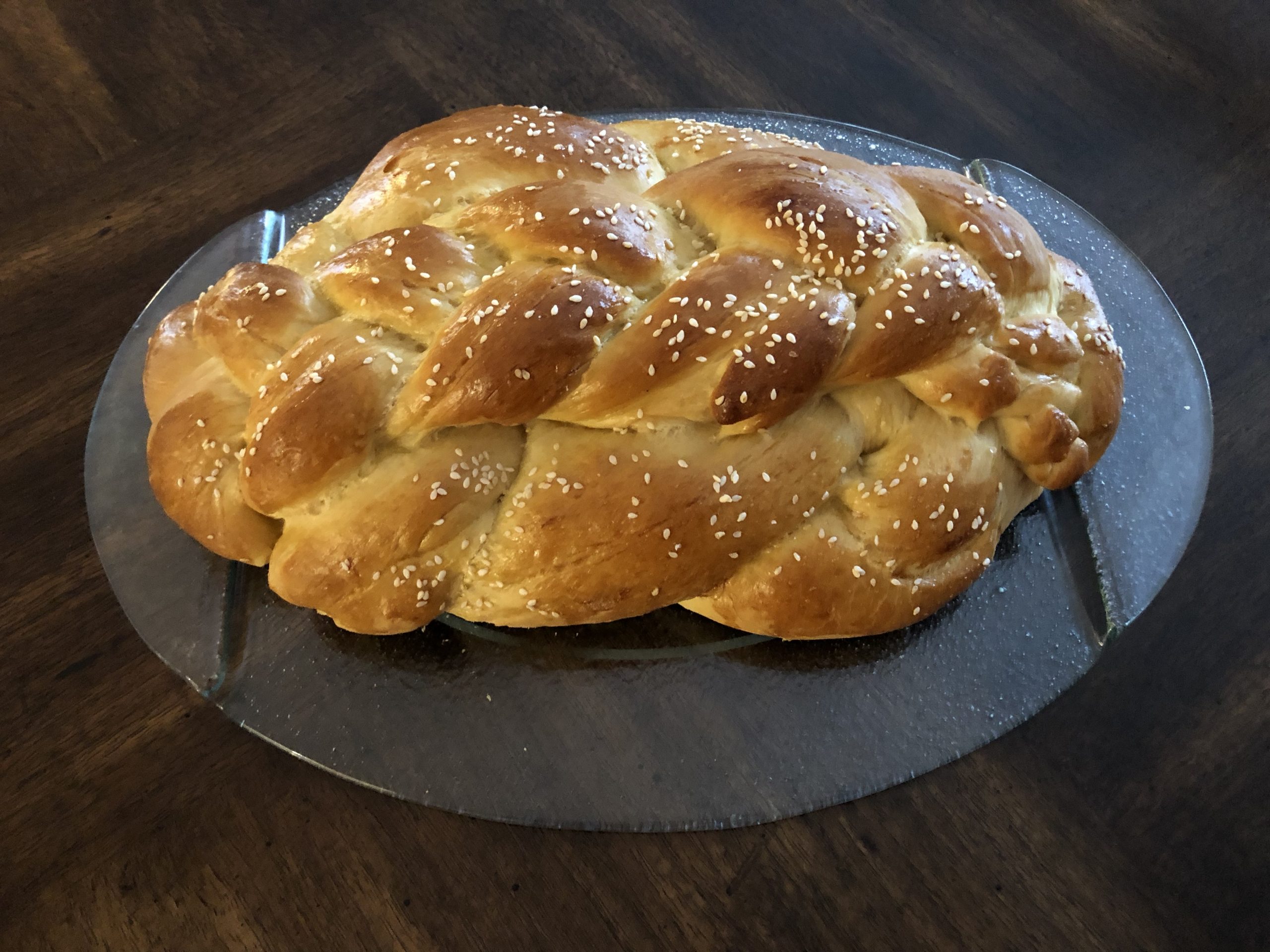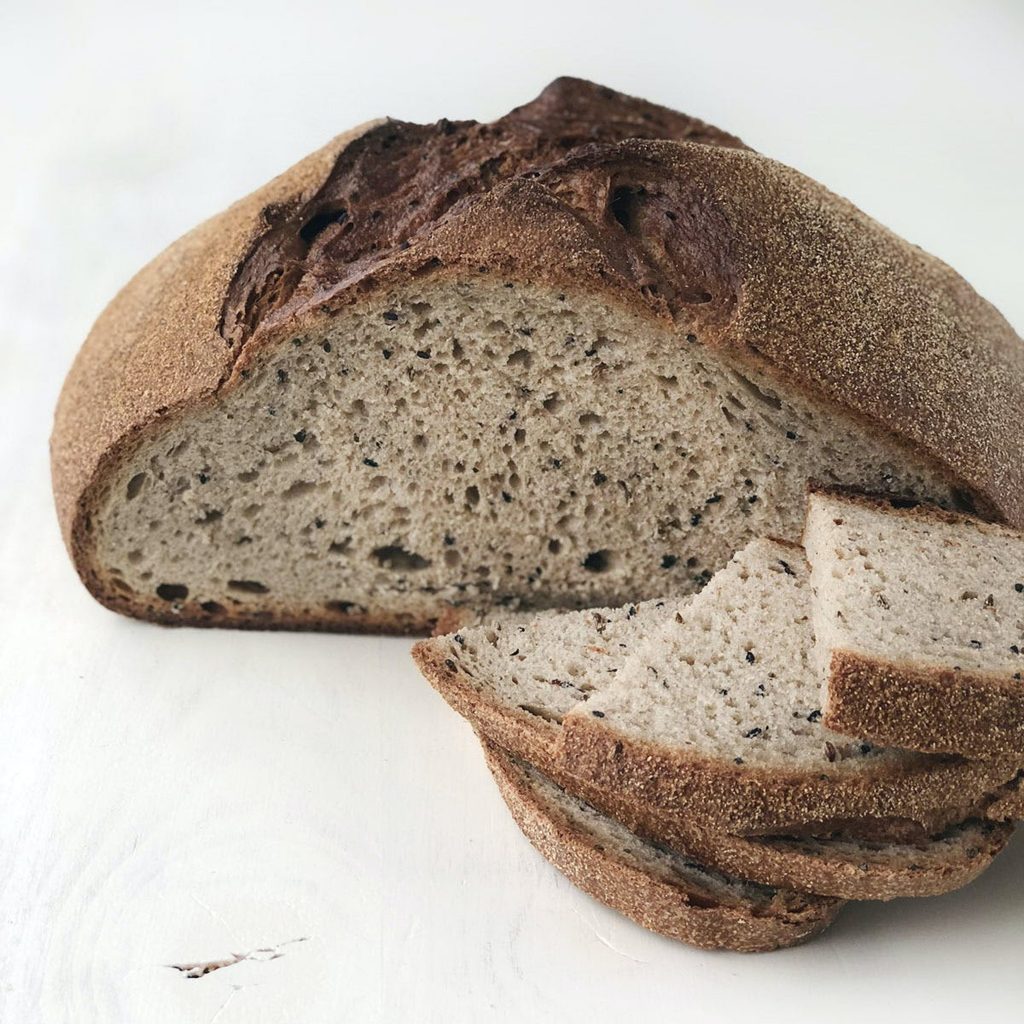
One of my creations
Of course, I love all sorts of comfort foods — sweets, chips, anything home baked — but if I’m being honest, my main source of eaten comfort is a good slice of bread. Some of my earliest childhood memories are related to bread. One of my grandmothers made her own bagels in a huge pot in her basement. After boiling them, she baked them in the oven. Talk about fresh. My other grandmother thought chunks of bread mixed with sour cream and sugar was a great lunch for a child. While the thought of this delicacy clogs my arteries just picturing it, that’s how I was raised.
If I’m being honest, my main source of eaten comfort is a good slice of bread.
My mother had her own notions about what constituted good bread and served it with most dinners. It had to come from a bakery, never from the grocery store. Her favorites were dark, peasant bread and what she called a good Jewish rye. She also taught me to appreciate the end piece because she convinced me that most of the nutrients were contained in the crust.
As a parent, I did not keep good bread in the house. My kids preferred their PB&J on Wonder Bread. I was never tempted to eat that. The only time I succumbed to my addiction was on visits to my parents, who continued to eat that great bread on a daily basis, or in restaurants when there was an excellent bread basket.
All of this changed when I learned how to bake Challah bread from scratch. Of course, once I had the recipe for what I called Batya’s bread (source of the recipe) and had mastered the technique, I made it often. Too often. Everyone loved it, especially when it was fresh and hot, just out of the oven. It needs no butter in my opinion. Just that steaming slice does me in. Perhaps it awakens something in me that takes me back to my early childhood memories of being with my grandmothers.
It must be my Lithuanian roots that cry out for a great slice of bread to restore the comforts of my childhood and shelter me from today’s snow storm and Omicron.
Boomer. Educator. Advocate. Eclectic topics: grandkids, special needs, values, aging, loss, & whatever. Author: Terribly Strange and Wonderfully Real.




Great story, Laurie. And you don’t have to be Lithuanian….. It is the taste and the memories, to be sure. But also that wonderful aroma while baking or just baked.
I’m really impressed that you make Challah form scratch. I came to it later in life, but it is truly ambrosial. Thanks for making my mouth water.
I can send you the secret recipe if you want. It’s not really that hard, but you have to be home most of the day (not a problem these days) to let the dough rise and punch it down twice. After you braid it, it has to rise again. But definitely worth it!
Mmmmm…challah….
Challah is one of the world’s Great Breads (along with Naan and an Italian roll from DiFillipis’ Bakery in Bayonne, NJ). Challah French toast is indescribably delicious!
Right on, Dave. I may have to make a loaf now.
Amen – challah makes the best French toast!
Good bread is indeed the staff of life—and fortunately easier to find than it seemed to be when I was growing up. European bread and bakeries are such a joy. Your challah sounds delicious, and looks fantastic too. I was always dissuaded from making yeast bread that had to rise and get punched and so on, but definitely enjoy eating the end result!
Making challah is easy but a full day commitment due to all of that rising and punching down. We do have wonderful bakeries nearby, but I try not to indulge my bread addiction too often these days.
You didn’t mention that good challah makes the most amazing French toast–if you can get the family to stop eating it and there’s still some remaining in the morning! Yours is gorgeous, you would have to fight them off to preserve any, I’m sure.
Your writing was very descriptive and evocative and conjured up many images as I read. For instance, that sugary treat you described from your grandmother called back to mind that my dad would once in a while (like not even once a year) have a chocolate bar sandwich–not the rest of us, just him! It involved melting an entire small Hershey’s bar (i guess in a pan on low heat in a stove, pre-microwave days) and then plopping it onto a piece of toast.
Dale, like Dave you remind me of making French toast with challah. But your suspicion that there is not enough left for doing that the next day is correct. My kids and grandkids gobble it up. OMG for your father’s chocolate bread. As the daughter of a chocolate loving dad, I get it. If my father could have convinced my mother to make that for him (he never touched the stove), he would have loved it.
Your challah loaf looks outstanding, Laurie. And it’s now pretty much impossible to get real “Jewish rye” here in California. Congrats to you for baking. There was no Wonder Bread allowed in our house while I was growing up, so I learned to appreciate the good stuff, just like you.
I think I gave my kids Wonder Bread for two reasons. One was they demanded it, and two was I knew I wouldn’t be tempted to eat it.
Homemade bread of any type is the best! Your challah looks amazing – are there four strands in the braid rather than three? My husband has taken to making sourdough bread, and after it comes out of the oven, I often sit and eat several slices plain, just as you describe with your challah.
The traditional challah is made by braiding 3 strands of dough. My recipe is enough to make 2 traditional loaves. To make a big one like the one in the picture, I divide the dough into four pieces and create a second smaller challah on top of the traditional one with 3 thin braided pieces.
I agree Laurie, I’ll take a good piece of bread – the crustier the better – and I’ll pass the bottle of olive oil on the table.
I tell the waiter, Butter please!
If the bread is fresh, hot, and really good, I can skip the butter and olive oil. I’m a pure bread fan!
I, too, have Lithuanian roots, Laurie and your Featured photo had my mouth watering. Though I’ve tried to limit my bread in-take for the past 9 years as part of my healthier eating habits, there is nothing as delicious as a good challah, which I will indulge in from time to time (and always a round one for the High Holidays).
I am not a baker, but my sister-in-law is fantastic! She made one for every table for her son’s rehearsal dinner and wedding last summer, as well as every Friday night for my brother’s household. I’ve sat with her and watched. She doesn’t even think about, just zip, zip.
I am in awe of those of you who can do that.
I never thought I could make challah because my mother always bought it from a good bakery, along with her Jewish rye and dark bread. But once someone showed me, I realized how easy it is if I have the time to wait for those 3 rises before baking it. You are lucky to have a sister-in-law who made challah for your son’s rehearsal dinner. I make mine for special occasions but not for every table.
SOS…send challah!
Want the recipe?
Thanks, but bread is one thing I just don’t have the patience to make…except for banana bread, which isn’t really bread. Your challah looks magazine perfect…just beautiful, I can almost smell it. YUM!
Banana bread with chocolate chips carried us through year one of the pandemic. Something to look forward to mid-afternoon.
I love bread. Almost any bread with butter. Your challah w butter: mmmm, I pause for a moment to taste the thought. But also a good rye bread, and a crunchy French baguette, and any bread from a bakery, and I bet your grandmother’s homemade bagels 🥯 were fab. I have some Litvak in me too, is there a special connect between a Lithuanian Jewish palate and bread?
Definitely a connection, as we come from peasant stock of poor Litvaks and bread was a cheap way to stave off hunger.
I am unlinked to the particulars of my forbears’ Litvak lifestyle, level of prosperity, and intellectual attainments, although I recall hearing that an esteemed rabbi was in the clan (maybe all diasporic Litvak families entertain that elevated and undocumented memory), and I also recall attending (many years ago) a reunion of remote relatives of my Litvak grandfather (who emigrated circa 1895, graduated Harvard AB 1909, and died young when I was 5 years old, a loss which I still feel), and, as proof of something, all the males of my generation in attendance were named “Jonathan David” (as I am), and looked exactly like me. If there is ever a repeat of the event (which I doubt), I will make inquiry of bread preferences and recipes among the surviving Jonathan Davids.
My mother used to claim borsht was also a big favorite. Who knows now?
And another thing, I just bought your book on Amazon (“Terribly Strange…””), perhaps hoping among other things to read some time-battered Lithuanian recipes, some home cooking. I opened up to your essay entitled “My Grandkids Can’t Read My Recipe Cards” and commend you for its poignancy, but not out of control poignancy. I from time to time will read my late wife’s handwritten recipes, in her sweet hand, bringing out her sweet disposition, which sets me yearning.
I am so sorry for your loss. I understand how seeing your late wife’s handwriting on those recipe cards would evoke feelings of love and nostalgia. One of my grandkids asked me to text her a sample of my mother’s handwriting (I have no idea why) and I sent her a picture of a recipe card.
Thanks for buying my book. I wrote it right after my mother died and when I was still focused on that loss, my retirement, and issues related to having young grandchildren and education (my career). Now, I find I want to write memoir pieces, including about my Litvak roots. I created a Mixbook of memoir pieces I have been working on in my local writing group, along with relevant photos. My plan was to give one to each of my children for them and their kids. I know one of my grandsons read it, but I think it was largely an exercise for me. Lately, I have been writing pieces about what little I know of my grandparents generation. I guess I’m thinking back, as Retro commands.